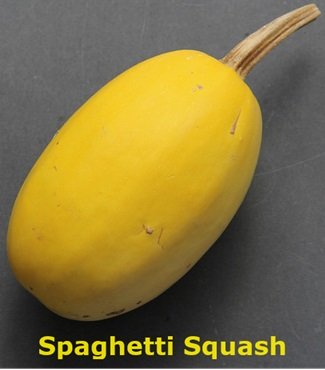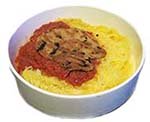Spaghetti Squash Nutrition facts
Spaghetti squash, another popular winter squash cultivar within the cucurbita (gourd) family of vegetables, stands out for its thick, pasta-like fibers. It is often referred to as "vegetable-spaghetti" due to these unique qualities. Its low carbohydrate content and nutrition-rich thicker strands make it a suitable alternative to cereal noodles, particularly for individuals with gluten sensitivity.
Similar to other members of the Cucurbitaceae family, such as pumpkin, acorn squash, cucumber, zucchini, and others, spaghetti squash is a fast-growing vine or bushy shrub.
Scientific name: Cucurbita pepo spp.
 |
| Courtesy: Simon Huntley |
Spaghetti squash thrives in well-drained loamy soil. The plant exhibits monoecious characteristics, producing distinct male and female flowers. Approximately 45 days after germination, the fruit begins to emerge, reaching harvest readiness between 70 to 85 days.
The fruit, resembling a cylindrical pod with rounded ends, features a cream-yellow/orange hue and a smooth, tough rind measuring 7-9 inches in length and 4-6 inches in width, typically weighing around 3 pounds. Its robust rind, marked by light, vertical ribs, encases the flesh.
Internally, the squash displays golden-yellow to orange flesh, its color influenced by polyphenolic pigments akin to those found in pumpkins. The fruit reveals a hollow center filled with numerous small, off-white seeds arranged in a net-like pattern. These seeds are a valuable source of protein, minerals, vitamins, and omega-3 fatty acids.
Health Benefits of Spaghetti Squash
Similar to other winter squashes, spaghetti squash is a highly nutritious vegetable with low calorie content. With just 31 calories per 100 grams, it contains no saturated fats or cholesterol but is packed with dietary fiber, antioxidants, minerals, and vitamins.
Dieticians often recommend spaghetti squash as part of cholesterol-controlling and weight reduction programs.
Its flesh, along with its strands, provides a significant amount of dietary fiber. This fiber aids in binding cancer-causing toxins and chemicals in the colon, thereby protecting against inflammatory bowel disease (IBD), cancers, and diverticulitis. Additionally, it helps in reducing fat absorption and lowering blood LDL-cholesterol levels.
Rich in antioxidant vitamins such as vitamin A, vitamin C, and carotenes (albeit in smaller amounts compared to pumpkins), spaghetti squash supports skin and mucosa integrity. Vitamin A, in particular, is vital for healthy eyesight and acts as a powerful natural antioxidant.
Studies suggest that natural foods abundant in vitamin A may aid in protecting the body against lung and oral cavity cancers.
Spaghetti squash is notably high in B-complex vitamins like folates, niacin, and vitamin B-6 (pyridoxine) compared to pumpkins.
Additionally, it serves as a modest source of minerals such as zinc, copper, calcium, and phosphorus.
Spaghetti squash kernels are a valuable source of dietary fiber, mono-unsaturated fatty acids, protein, minerals, and vitamins that promote health.
| Principle | Nutrient Value | Percent of RDA |
|---|---|---|
| Energy | 31 Kcal | 1% |
| Carbohydrates | 6.91 g | 5% |
| Protein | 0.64 g | 1% |
| Total Fat | 0.57 g | 3% |
| Cholesterol | 0 mg | 0% |
| Dietary Fiber | 1.5 g | 6.5% |
| Vitamins | ||
| Folates | 12 μg | 3% |
| Niacin | 0.950 mg | 6% |
| Pantothenic acid | 0.360 mg | 6.5% |
| Pyridoxine | 0.101 mg | 8% |
| Riboflavin | 0.018 mg | 1.5% |
| Thiamin | 0.037 mg | 3% |
| Vitamin A | 120 IU | 4% |
| Vitamin C | 2.1 mg | 3.5% |
| Electrolytes | ||
| Sodium | 17 mg | 1% |
| Potassium | 108 mg | 2% |
| Minerals | ||
| Calcium | 23 mg | 2% |
| Copper | 0.037 mg | 4% |
| Iron | 0.31 mg | 4% |
| Magnesium | 12 mg | 3% |
| Manganese | 0.125 mg | 0.5% |
| Phosphorus | 12 mg | 2% |
| Selenium | 0.3 μg | <0.5% |
| Zinc | 0.19 mg | 1.5% |
| Phyto-nutrients | ||
| Carotene-α | 16 μg | -- |
| Carotene-ß | 64 μg | -- |
Selection and storage
You can typically find spaghetti squash year-round at markets. Look for well-developed squash by pressing firmly with your thumb to ensure they're firm. Another way to gauge maturity is by tapping for a woody sound; mature squash will have solid, dry stems.
Avoid squash with soft spots, cuts, or bruises, as well as those with skinny, green stems.
Typically, farmers cure fresh squash before sending it to market, which extends its shelf life and makes it suitable for longer transportation distances, resulting in better prices.
At home, store squash in a cool, well-ventilated place. Cured squash can remain fresh for up to 3 months or more when stored in a cool, dry area.
However, once cut, squash sections should be used immediately or stored in the refrigerator wrapped in plastic for 2-3 days.
Preparation and serving methods
Wash the fruit in cool water to rid of any surface dirt. Spaghetti is generally cut in half lengthwise. Discard the seeds and place the cut side down in an oven-safe baking pan. Drizzle some olive oil cover the pan with ¼ inch water and microwave on high until soft. When the squash cooled, scrape out the inside with a fork uni-directionally towards you to get "noodle-like" strands.
As in acorns, all the parts of the plant- fruit, leaves, flowers, and seeds are edible.
Here are some serving ideas:
 |
 |
| Noodle-like strands being seperated from boiled squash. Photo courtesy: Rusty clark | Spaghetti-squash topped marinara-sauce Courtesy: Emily Allen |
-
"Vegetable spaghetti" can be used in various delightful recipes as a substitute for wheat noodles.
-
Toss squash "noodles" with olive oil, parmesan cheese, garlic, and black pepper.
-
The squash "noodles" topped with marinara tomato sauce are a popular choice.
-
It can also be used to create dishes like quiche, omelet, souffle, and more.
-
Furthermore, it's utilized in chicken and seafood recipes.
-
Roasted squash seeds (Pepita) make a tasty snack option.
Safety profile
Allergic reactions to spaghetti squash are rare. Pregnant women and infants can safely consume it. (Medical disclaimer).
Also read ≻≻-
≺≺ Pumpkin Nutrition facts.
≺≺ Acorn squash Nutrition facts.
≺≺ Back to Vegetables from Spaghetti squash nutrition. Visit here for an impressive list of vegetables with complete illustrations of their nutrition facts and health benefits.
≺≺ Back to Home page.
Further reading:
Stanford School of Medicine Cancer information Page- Nutrition to Reduce Cancer Risk (Link opens in new window).